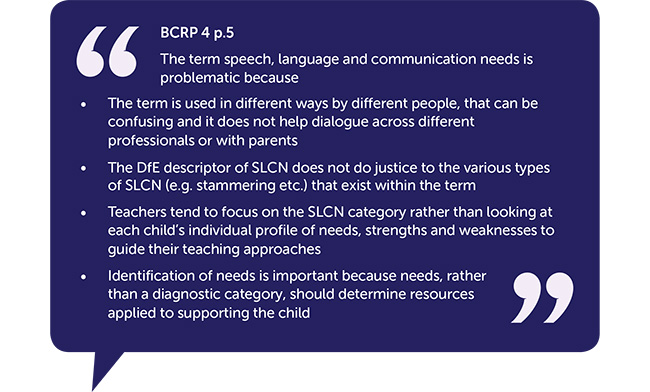Needs analysis
The understand and plan parts of the commissioning cycle focus on the needs analysis, identifying the outcomes, and describing the provision required to meet the need.
The BCRP outputs provide useful evidence to inform these stages. Key themes identified in the research include:
- Being clear about describing accurately the children and young people who are the focus of the needs analysis
- Being clear about identifying the number of children and young people
- How their needs may change over time
- Using evidence of prevalence and associated factors that influence predicted need
- Understanding issues arising from the interface and over-lap between SLCN and other categories such as Autistic Spectrum Disorders (ASD) and Behavioural, Emotional and Social Difficulties (BESD)
Defining the target population
One of the first key findings of the BCRP was that there is need to review the current SEN category of SLCN due to the significant variation in what the term ‘SLCN’ means to different groups of professionals and in different policy areas.
This is discussed in thematic report BCRP 4 ‘Understanding speech, language and communication needs: Profiles of need and provision’ (2012)14.

The term SLCN has become commonly used over the past decade as an umbrella term for all speech, language and communication needs. This is the case both within the speech and language therapy profession15 and subsequently in the Bercow Review and Better Communication Action Plan16 , 17 as well as the through the work of the Communication Champion and during the Hello campaign in the national year of communication18.
The SEN category ‘SLCN’ in an educational context refers specifically to children and young people whose primary learning need has been identified as being speech, language and communication. In the SEND reforms, the SEN term SLCN sits within an umbrella term of Communication and Interaction, alongside ASD. The number of children with a primary need of SLCN will represent only a small proportion of those who require support for speech, language and communication.
The majority of pupils with SEN have some degree of SLCN; for example, those with primary need of ASD, Hearing Impairment, and some children with a primary need described as moderate learning disability, profound and multiple learning need or physical disability will also require provision to be commissioned from speech and language therapy and other services which support SLCN.
The difficulty with the diagnostic categorisation currently in place as part of the SEN system is that it complicates the analysis of overall speech, language and communication need within a population.

IMPLICATIONS FOR COMMISSIONING

14. Dockrell, J., Lindsay, G. & Ricketts. J. (2012). Understanding speech, language and communication needs: Profiles of need and provision. London: DfE. (Thematic report: BCRP 4)
15. Gascoigne, M.T. (2006) Supporting children with speech, language and communication needs within integrated children’s services RCSLT Position Paper. http://www.rcslt.org/docs/free-pub/Supporting_children-website.pdf
eOrderingDownload/Bercow-Report.pdf
17.Better Communication Action Plan (DCSF, 2008) eOrderingDownload/Better_Communication.pdf
